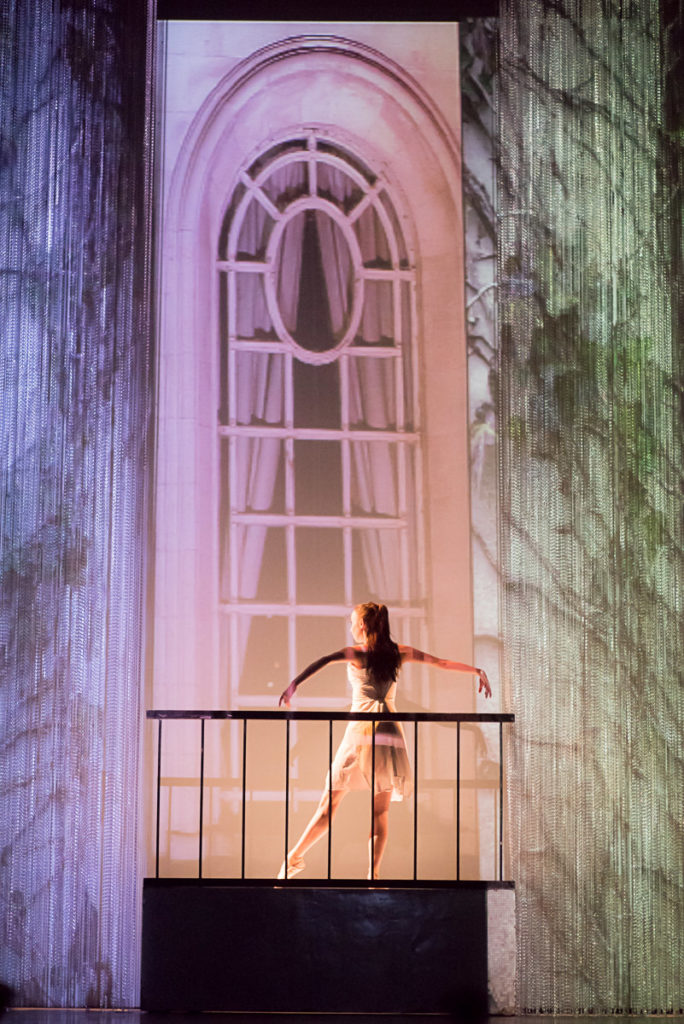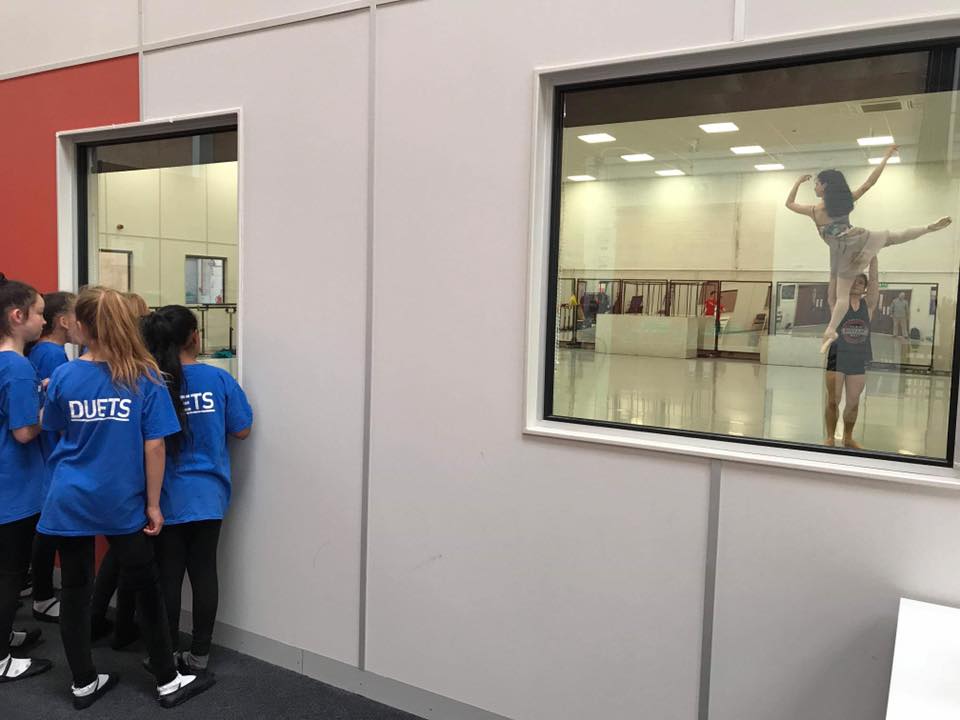 (4.5 / 5)
(4.5 / 5)
Infused with that distinctly Welsh edge that sets this company apart from others, the opening night for Ballet Cymru’s 2019 tour of Romeo a Juliet was a breath-taking spectacle of love, loss, power and pain. Featuring choreography from Darius James OBE and Amy Doughty, alongside Prokofiev’s classic score, a number of new dancers to the company (and to Wales) joined the more experienced faces that will be familiar to followers of Ballet Cymru. This performance demonstrated the real depth of talent that the company attracts, nurtures, and advances.
In her premiere professional performance, dancer Danila Marzili embodied Juliet with infectious passion and grace, effectively conveying the playful and childlike elements of the character as well as the inimitable pain and heartbreak leading to her death. In her opening scene, Marzili and Krystal Lowe (portraying Juliet’s friend, her confidante, rather than her nurse) expressed such a tangible affinity with one another that, immediately, I was transported directly from Newport into Juliet’s chambers. The scene ends, along with Juliet’s childhood, as she is introduced to her arranged fiancé, Paris, danced energetically by Joshua Feist in his own premiere performance with Ballet Cymru.
Opposite Marzili as Juliet, Romeo was performed by Andrea Maria Battaggia. Battaggia is a skilful dancer who returned to Ballet Cymru this year from Ballet Ireland. Having portrayed the role in 2013, this performance demonstrated the reasons behind this reprisal in 2019. His strength and passion deliver the character’s impulsiveness, tenderness, and emotion with expert flair.
Two real stand-out performances for me were two characters that are usually side-lined as secondary in the story of Romeo and Juliet. Alex Hallas and Beth Meadway, portraying Lord and Lady Capulet, conveyed strength, coldness, wealth, and power through their bodies in such a way that every time they stepped on the stage, they owned it. The costumes adorning these two characters were highly effective at complementing their status. Meadway’s dramatic poise and striking elegance as Lady Capulet was phenomenal; only to be given more depth by the implied affection between her and Tybalt (performed adeptly by Robbie Moorcroft) and her subsequent breaking down into anguish and distress at his death. This performance makes it vastly clear that these dancers are also capable actors, with every performer fully embodying and embracing their roles on the stage.
Perhaps it’s cliché to mention, but I am unable to write a review of Romeo a Juliet without referencing the balcony scene. Expertly choreographed by James and Doughty, and skilfully danced by Battaggia and Marzili to express curiosity and the passion, this famous and relatable interaction proved hugely popular with the very diverse audience present in the theatre. The setting of this scene took my breath away; the projection of a grandiose window and the stage lighting to define the setting accompanied a simple yet effective podium to demarcate the balcony. For my daily work, I spend a lot of my professional time at the headquarters of Ballet Cymru in Rogerstone, Newport. From the first sighting of this balcony while the company were in early rehearsals, I had a real desire to go full-Romeo with, “but soft, what light through yonder window breaks?” but alas, my acting days were short-lived and I struggle to keep a straight face anymore!

Minimalistic sets are indicative of the work of Ballet Cymru. Predominantly on the stage were moveable sheets of hanging chains which conveyed elements of wealth, grandeur, and battle. Designed by Georg Meyer-Wiel, this feature was highly effective in delineating space, serving as backgrounds for projection, and expressing the well-known building blocks of the plot of Shakespeare’s Romeo and Juliet. Meyer-Wiel also designed the dancers’ costumes, with some real stand out pieces (I couldn’t decide which I preferred: the powerful black costumes of Lord and Lady Capulet, or Friar Lawrence and his entourage dressed in leather). One small criticism, however, is that I feel Paris’ green- jacketed costume was too similar in colour to that of the Montagues, and perhaps would have been more prominent if it reflected those of the senior Capulets.
Every piece of work produced by Ballet Cymru that I have seen has had intrinsically Welsh notes running through. Led by Artistic Director and proud Newport local Darius James OBE, it would be surprising to see a show from this company that didn’t include at least a few nods to Welsh culture and heritage! Romeo a Juliet did not disappoint: the title itself, a nod to the Welsh language; the projection of underneath a Newport flyover during one of the fight scenes, open to interpretation but definitely Newport; the incorporation of traditional Welsh clog dancing in time with Prokofiev’s Dance of the Knights/Montagues & Capulets… Admittedly, I wasn’t sure what to expect of clog dancing mashed up with ballet (and neither were my parents, who were visiting from across the border), but when the dancers were clogging in reasonably good time with the music – masked in hoods that covered their whole faces – Lord and Lady Capulet entered, performing in a more classical ballet style befitting of their characters. The strength demonstrated by the dancers – particularly Robbie Moorcroft (Tybalt) – whilst clogging was palpable. It is this kind of flair that sets Darius James and Ballet Cymru as a real formidable force in Wales, because this scene worked. It was memorable; it was powerful; it was Welsh. And it worked.

Image credit Sian Trenberth
An integrally important responsibility of Ballet Cymru, and many other arts organisations around Wales, is to improve diverse representation within their audiences and share their art form with people who may never have entered a theatre, never mind seeing a ballet. Ballet Cymru’s Duets programme, which seeks “to support people to access dance, regardless of background, finances, race, belief, ability, and gender/orientation”, invited a number of its scholars (participants) from Moorland Primary School in Splott, Cardiff to perform the curtain-raiser at both tour dates in Newport.

Aptly named Romeo and Duets, the young people danced with skill (and to rapturous applause!) to Karl Jenkins’ Palladio, as performed by Escala. To complement this, complimentary tickets for the show and coach travel back to Cardiff were made available for the young people and members of their families. As a male adult beginner of ballet myself (I’m still aching from my second ever class as I write this!), it was refreshing to see how many boys were involved in this curtain-raiser.

It is always stimulating to see audience members experience something for the first time; four people sat on my row had never seen a ballet before, and were supporting their children in the Duets curtain-raiser. Ballet Cymru’s diverse audience, particularly when on home turf in Newport, creates a fresh and responsive feel amongst the audience which in turn connects them to the ballet they are watching. A real audience favourite was the ever flamboyant, provocative, and playful Mercutio (portrayed perfectly by Miguel Fernandes); a real excitement built up in the auditorium when he graced the stage with his presence, and almost tangible grief (at least on my row!) when Tybalt took his life at the end of Act II.
Ballet Cymru’s 2019 tour of Romeo a Juliet will continue across the UK throughout June and into July. In addition to this, in partnership with Wales Arts International, the company will be touring three cities in China throughout September 2019. Clearly, the sky is the limit for this dynamic, engaging, and passionate company and I’m excited, as ever, to see what Ballet Cymru has planned next!

